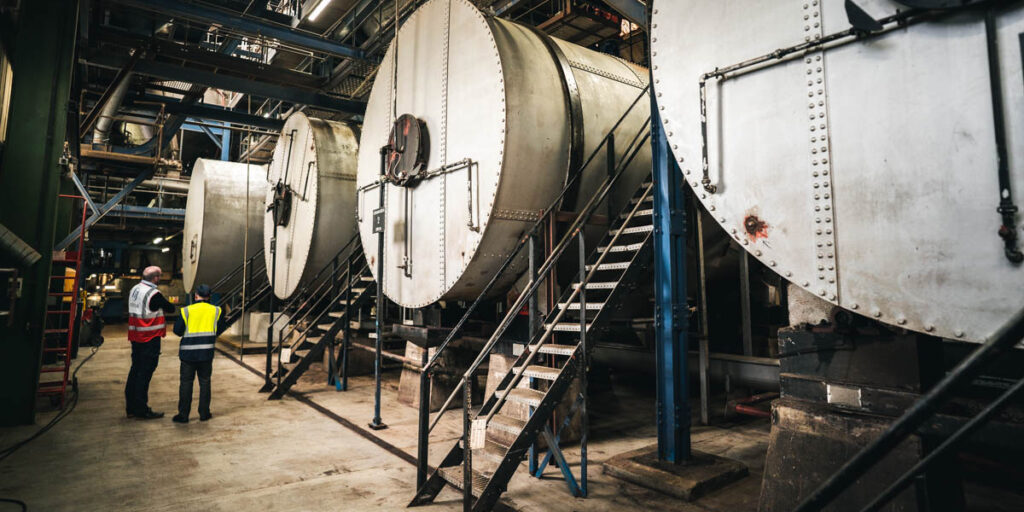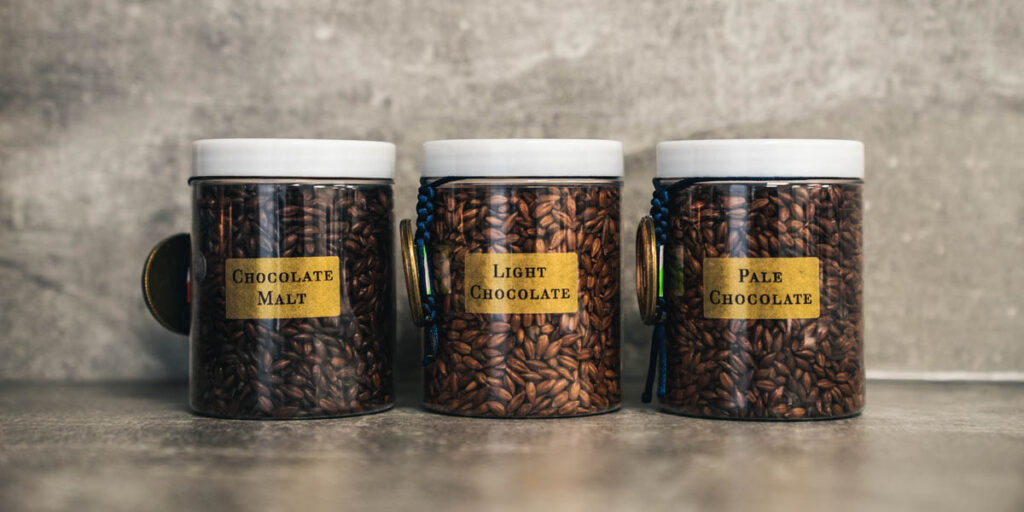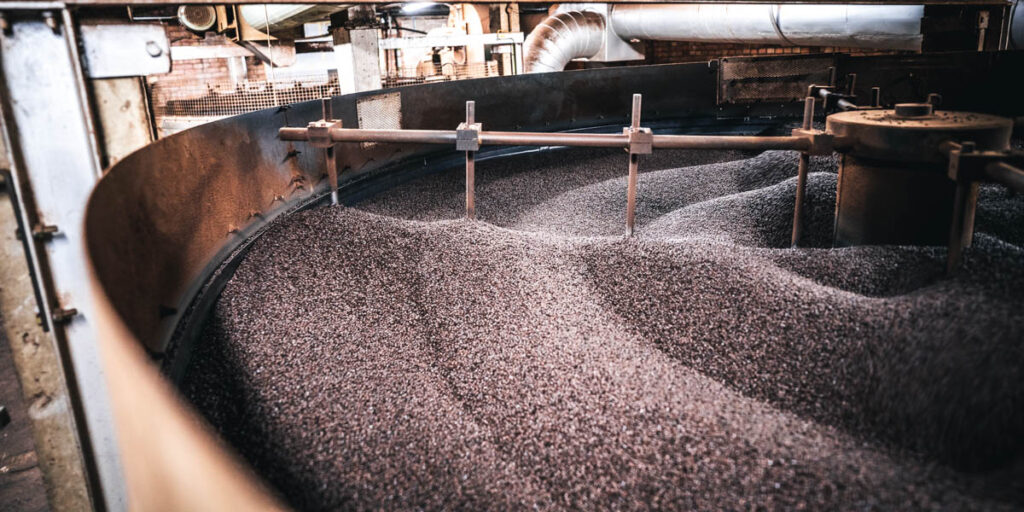A Deep Dive Look at the Roasting Malt Process

When it comes to beer making, roasting malt is a crucial step in the process. Roasting malt helps to develop the flavours and colours of the beer. It’s an essential part of brewing a great-tasting beer. In this deep dive look at the roasting process of malt. We’ll explore the steps to roasting malt, the differences between different types, and some tips for getting the most out of your roasting experience.
The basics of roasting malt
Making malt starts with the grains being steeped in water for 2-3 days. After that, the grain is moved to the kiln for drying for Patent malts or the germination drums for Crystal malts. The germination process takes 4-5 days; during this time, the grain’s starches are converted into sugars. Once done, the grain is dried and roasted to caramelise the sugars. Depending on how long the grain is roasted, it can become a light, medium or dark roast. Light roasts are often used for crystal malts and chocolate malts. Darker roasts are used for roast barley and patent malt.
The roasting operator samples the drum and compares the flour to a known sample. Once satisfied with the roast level, they discharge the drum to the cooler and blow it with ambient air to stop colour development and stabilise the flavour profile. A blend of different malts can be used for certain types of beer to achieve desired flavours. For example, pale ales may blend pale ale malt and crystal malt. While porters and stouts may blend pale ale malt, crystal malt, chocolate malt and roast barley. In some cases, patent malt is also added to enhance body, flavour and mouthfeel. By combining different types of malts, brewers can control their beers’ flavour profiles and characteristics.
Finally, after all, types of malts have been blended, they are then milled together before brewing. This ensures an even mix of malt types when adding them to the mash. Patent malt has a particularly high enzyme content due to its longer roasting time. This helps break down starch molecules into sugar molecules. This creates a fuller body and enhances other flavour compounds from crystal malt, chocolate malt and roast barley. Balancing each type of malt’s flavour contribution is key when using multiple types of malt in one recipe. Too much patent malt will produce an unbalanced, overly sweet beer; not enough will yield an overly bitter one. Working with various flavours created by these different malts gives brewers greater control over creating unique and delicious beers.
The difference between light, medium, and dark roast
Light roast has a light brown colour and a toasted grain taste. This type of roast is often used in lighter beers, such as pilsners or cream ales. The malt may include crystal, chocolate, or even roast barley. It has a higher acidity and a lighter body, making it a great choice for adding a subtle roasted flavour without being overpowering.
Medium roast has a darker brown colour and a stronger toasted grain taste. This type of roast often includes patent malt, which adds an even more intense flavour profile. The flavour is balanced, and the body is fuller, perfect for darker beers such as brown ales or stouts.
Dark roast has an oily surface and a bitter taste. It is mostly used for black beers, such as porters and schwarzbiers, and is the darkest of all the roasts. The smoky flavour is more intense, and the body is heavier, making this roast the most complex and flavorful.

The crystal malt process
Crystal malt is made from steeped and germinated green malt, which is then put into a roasting drum and heated gradually. The temperature is slowly raised to convert the starch in the malt to sugar. It is then gently roasted to the desired specification.
At inclusion rates between 3 and 10%, a low-colour crystal malt will provide delicate notes of sweet caramel, golden syrup, malty-biscuity notes and an infusion of nuts and dried fruits. Introducing darker crystal malts, such as chocolate or roast barley malt or even patent malt, brings greater flavour intensities with powerful black treacle notes standing out supported by layers of rich caramelised sugar, roast coffee, a delicate bitterness and prominent rich dried fruits and nuts. Adding too much can result in bitter and burnt notes but used correctly. It can add great complexity to any beer style. For example, a robust porter could benefit from some patent malt for an intense mouthfeel and burnt sugar character. Stouts can get a great character from roast barley and chocolate malt additions for that classic dry finish.
Of course, many recipes are available for different styles involving various amounts of these crystal malts. Each offering special contributions to a beer’s character. Ultimately, it is up to the brewer to find what works best for them to create their desired flavours.
The patent malt process
Patent Malts are made from barley or kiln-dried malt. Their name comes from the 19th Century when a special license or “patent” was needed to sell them. Patent Malts range from lightly roasted Amber and Brown to Black and Chocolate. They have strong flavour and aroma characteristics and are often used in various beer styles such as Porters, Stouts, Ales, and even some lagers.
The patent malt process combines crystal malt with roast barley, chocolate malt, and other speciality malts to achieve the desired colour and flavour profiles. These unique malts impart complex flavours and aromas essential for creating a robust beer. Crystal malts provide sweetness and caramelization, while chocolate malt provides notes of coffee, dark chocolate, and cocoa. Roast barley adds body and astringency, while patent malts contribute dark fruit characteristics like raisins and plums. When all these malts come together during roasting, they form a truly exceptional taste experience that will make any beer connoisseur happy.
The patent malt roasting process requires patience and skill. Each patent malt must be carefully monitored during roasting to ensure the ideal flavour and aroma profiles are achieved. This can be done through simple adjustments to the temperature, time, and airflow during the roasting process. After roasting, brewers must ensure all patent malts have been thoroughly cooled before adding them to the wort boil.

The flavour profiles of different roast levels
French & Jupps can produce a range of roast levels, each with its own unique flavour profile. From light and sweet to dark and intense, you’ll find a variety of flavours and aromas when selecting the type of malt for your project. Light roasts are sweet and light-bodied, with hints of honey and toffee. Medium roasts offer more complexity, with notes of nuts and cocoa. Dark roast levels bring out chocolate malt, roast barley flavours, and a subtle smokiness.
Try a speciality malt like crystal or patent for a truly unique flavour. These give the beer a deep richness and caramel sweetness that complements dark roasts perfectly. If you want to create your project using the finest malt with beautiful flavours and aromas, contact us today! We carry a large selection of crystal malts, patent malts, chocolate malts and roast barleys so you can craft the perfect brew. Crystal malts provide an incredibly smooth body and sweet caramel flavours while patent malts introduce nutty and biscuit notes. Chocolate malts add roasted coffee and cocoa flavours that balance out sweeter beers. Lastly, roast barleys impart a distinct bitter flavour with nutty undertones. By combining different types of malts, you can create complex layers of flavours that will make your brew stand out from the crowd.